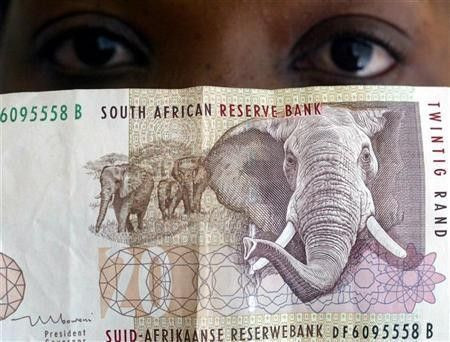S.Africa stocks tumble, rand slips as global markets weaken

South Africa's stocks fell more than 2 percent on Monday and the rand hit one-week lows to the dollar, with further losses seen this week as worries about the global economy and euro zone debt crisis persist.
The falls follow a global rout as a negative mood holds sway in markets after Friday's weak U.S. jobs data and as the euro zone stumbles through a sovereign debt crisis.
South African government bonds continued a rally that has seen yields fall by 40 to 50 basis points in the last month across the curve.
The blue-chip Top-40 index lost 2.3 percent to 26,554.09, its biggest one-day loss in two weeks, while the broader All-Share index gave up 2 percent to 29,888.14.
Miners, which are often the first to come under pressure when concerns over global economic growth set in, dropped 2.7 percent.
All the commodity stocks are taking huge hits because of sentiment on global growth, said Byron Lotter, portfolio manager at Vestact.
The anxiety is back on, fuelled by the U.S. jobs data. It's all about the American consumers, who are China's biggest customers.
The rand was trading at 7.1297 against the dollar at 1540 GMT, 0.67 percent weaker than Friday's New York close 7.0820. It hit a one-week low of 7.1361 earlier.
I do see further losses when the US re-enter the fray Tuesday, said Christopher Shiells, emerging market analyst at IGM, referring to U.S. markets re-opening after a long weekend.
Dollar/rand saw resistance around 7.1100 for most of the session, but the last bout of risk-averse trading was strong enough to break this and now 7.1600 will be eyed.
Investors will also be wary to pile on risky assets before the European Central Bank and Bank of England policy-setting meetings later this week, keeping the rand on the defensive.
MANUFACTURING DATA COULD BOOST BONDS
Locally, manufacturing output numbers on Thursday could see bonds gain further if they point to more economic weakness in the third quarter, after a sharp slowdown to 1.3 percent in the second quarter.
The 2026 yield fell 13 basis points to 7.84 percent on Monday and that on the 2015 bond was down 1.5 basis points to 6.35 percent, not far from a record low of 6.32 hit on Friday.
A Reuters poll showed the market is expecting a 0.6 percent year-on-year contraction in manufacturing output in July, a number that will harden the case to cut the repo rate, after the Reserve Bank left it steady at 5.5 percent this year.
On the bourse, platinum miners bore the brunt of the sell-off, the index falling 3.2 percent. The world's top producer of the metal, Anglo American Platinum, shaved 5.4 percent to 528.08 rand, its biggest one-day loss in more than 15 months.
BHP Billiton listed on the JSE closed 4 percent down at 222.59 rand after going ex-dividend, meaning those who buy the stock now won't receive the latest dividend.
Johannesburg-listed shares of Anglo American came in less 3.3 percent at 273 rand, after news the global miner would divest from South Africa's only producer of refined copper, Palabora, whose flagship mine the major sees as too small.
Gold miners such as AngloGold Ashanti benefited from the rout, adding over 2 percent to 328.95 rand.
This week started again with a lot of anxiety. Markets will have a lot of volatility. It will take some positive data to come through and a few up days to give some stability, Vestact's Lotter said.
© Copyright Thomson Reuters 2024. All rights reserved.





















